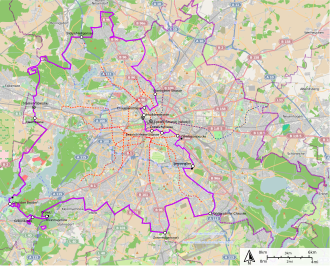East Germany
Former country in Central Europe
East Germany, officially known as the German Democratic Republic (GDR), was a country that existed from 1949 to 1990 in the eastern part of what is now Germany. It was established in the Soviet-occupied zone of post-World War II Germany and was a member of the Eastern Bloc during the Cold War.
History
Formation
East Germany was formed on October 7, 1949, following the division of Germany into occupation zones by the Allied powers after World War II. The Soviet Union controlled the eastern zone, which became the GDR, while the western zones, controlled by the United States, the United Kingdom, and France, became the Federal Republic of Germany (West Germany).
Political Structure
The GDR was a socialist state under the leadership of the Socialist Unity Party of Germany (SED). The political system was characterized by a single-party rule, with the SED holding a monopoly on power. The first President of East Germany was Wilhelm Pieck, and the first Prime Minister was Otto Grotewohl.
Leadership
Walter Ulbricht was a prominent leader in the early years of the GDR, serving as the First Secretary of the SED from 1950 to 1971. He was succeeded by Erich Honecker, who led the country from 1971 until the fall of the Berlin Wall in 1989.
Economy
East Germany had a centrally planned economy, with state ownership of industry and agriculture. The economy was heavily influenced by Soviet models and was integrated into the Eastern Bloc's economic system, the Council for Mutual Economic Assistance (Comecon).
Social and Cultural Life
The GDR promoted socialist values and sought to create a distinct East German identity. Education, healthcare, and social services were provided by the state. Cultural life was heavily regulated, with censorship and state control over media and the arts.
The Berlin Wall
One of the most significant symbols of the Cold War was the Berlin Wall, constructed in 1961 to prevent East Germans from fleeing to the West. The Wall divided Berlin into East and West and became a powerful symbol of the division between the communist and capitalist worlds.
Reunification
The fall of the Berlin Wall on November 9, 1989, marked the beginning of the end for East Germany. Political changes and public pressure led to the opening of the borders and the eventual reunification of Germany on October 3, 1990.
Related pages
Transform your life with W8MD's budget GLP-1 injections from $125.
W8MD offers a medical weight loss program to lose weight in Philadelphia. Our physician-supervised medical weight loss provides:
- Most insurances accepted or discounted self-pay rates. We will obtain insurance prior authorizations if needed.
- Generic GLP1 weight loss injections from $125 for the starting dose.
- Also offer prescription weight loss medications including Phentermine, Qsymia, Diethylpropion, Contrave etc.
NYC weight loss doctor appointments
Start your NYC weight loss journey today at our NYC medical weight loss and Philadelphia medical weight loss clinics.
- Call 718-946-5500 to lose weight in NYC or for medical weight loss in Philadelphia 215-676-2334.
- Tags:NYC medical weight loss, Philadelphia lose weight Zepbound NYC, Budget GLP1 weight loss injections, Wegovy Philadelphia, Wegovy NYC, Philadelphia medical weight loss, Brookly weight loss and Wegovy NYC
|
WikiMD's Wellness Encyclopedia |
| Let Food Be Thy Medicine Medicine Thy Food - Hippocrates |
Medical Disclaimer: WikiMD is not a substitute for professional medical advice. The information on WikiMD is provided as an information resource only, may be incorrect, outdated or misleading, and is not to be used or relied on for any diagnostic or treatment purposes. Please consult your health care provider before making any healthcare decisions or for guidance about a specific medical condition. WikiMD expressly disclaims responsibility, and shall have no liability, for any damages, loss, injury, or liability whatsoever suffered as a result of your reliance on the information contained in this site. By visiting this site you agree to the foregoing terms and conditions, which may from time to time be changed or supplemented by WikiMD. If you do not agree to the foregoing terms and conditions, you should not enter or use this site. See full disclaimer.
Credits:Most images are courtesy of Wikimedia commons, and templates, categories Wikipedia, licensed under CC BY SA or similar.
Contributors: Prab R. Tumpati, MD





